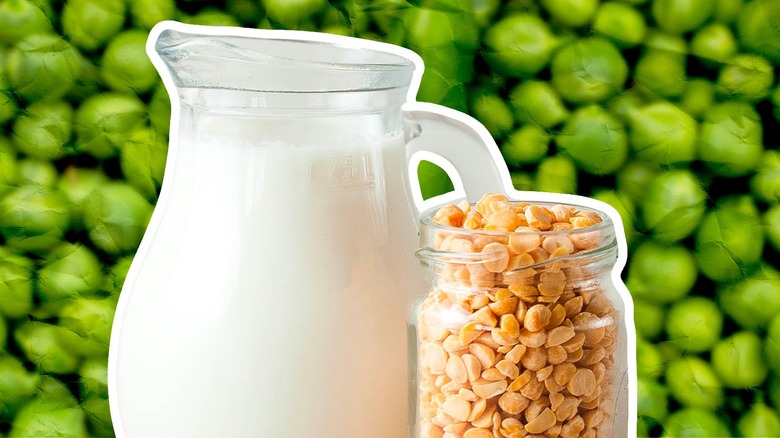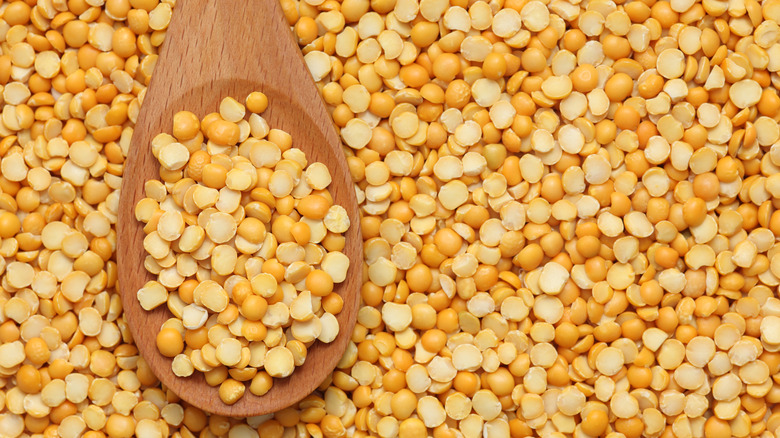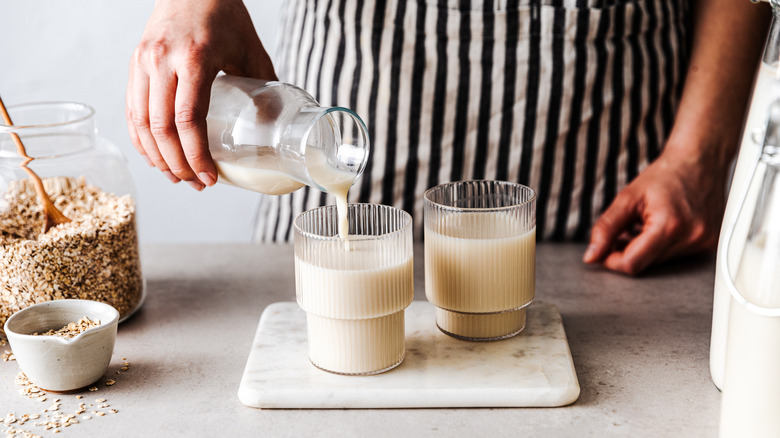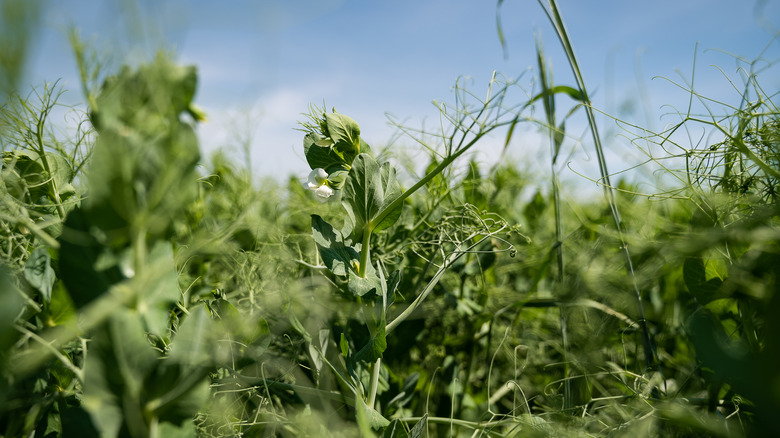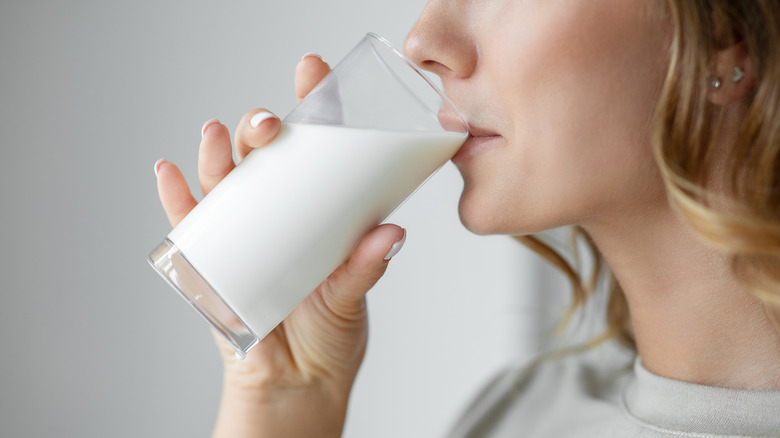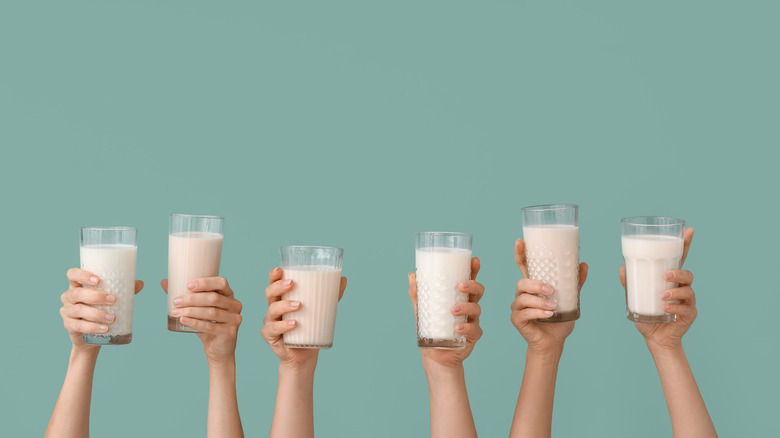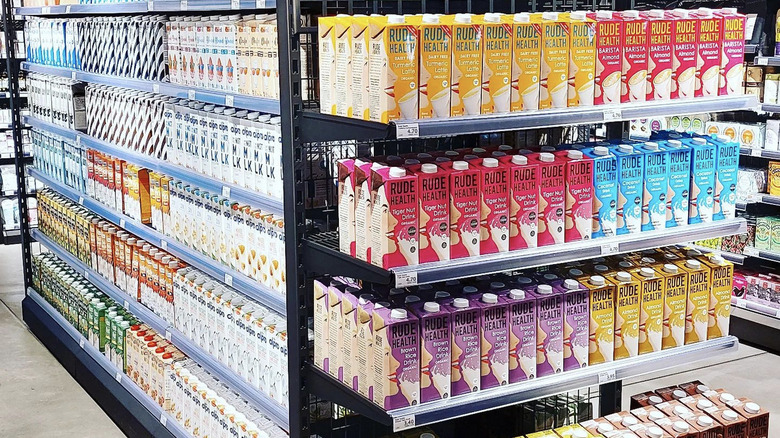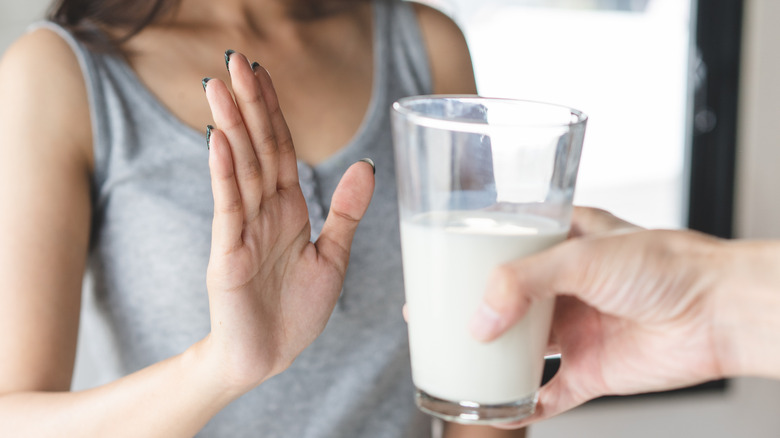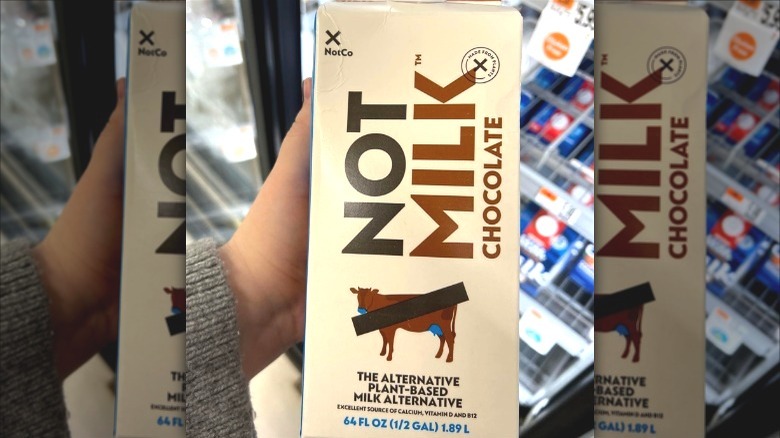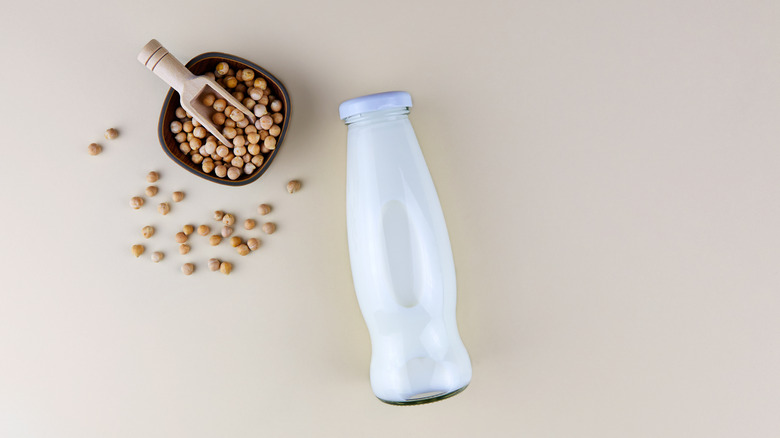The Ultimate Guide To Pea Milk
Pea milk may not initially sound as appetizing as almond or oat milk, but it's looking like the next big thing in the world of plant-based dairy alternatives. Boasting an enviable amount of nutrients, creamy texture, and low calorie count, it's poised to become the darling of the plant-based milk aisle — if enough people can get over the idea of drinking a vegetable. Judging by the enduring popularity of soy milk, they definitely can.
Since 2015, pea milk has seen a rapid rise in sales, with a 27% increase in 2022 alone. Investors can expect it to rise from $105 million in sales in 2022 to $283 million by 2032.
Considering these numbers, it's worth taking a closer look at this latest plant-based milk phenomenon to figure out whether it's worth all the hype. Brands are touting its unrivaled nutritional profile, dairy-mimicking flavor, and negligible environmental impact. But, as with all marketing, all those claims need a fact check. Whether you're a pea milk devotee or a complete novice, it's time to dive into the specifics of what this new vegan milk is all about.
It isn't green
We know what you're thinking: all peas are green, so a milk made from them must be, too. But while it's true that many of us associate peas with a vibrant lime color, the ones used to make milk are actually yellow. Green and yellow split peas are similar nutritionally, but the flavors are slightly different. Green peas have a fresh sweetness that makes them a perfect addition to soups and stir fries, while yellow peas are earthier, with a nutty flavor that is similar to lentils.
Because pea milk is made with yellow split peas, it has a similar off-white color to oat and soy milk rather than the spitting image of celery juice. This makes it easier for brands to market pea-based dairy alternatives to people who might not want to see green when they look into their bowl of Cheerios. Then again, as the plant-based milk market becomes increasingly competitive, green pea milk might be a savvy marketing tactic to win attention in a crowded field.
It's made in a completely different way to oat milk or nut milks
How many ways are there to extract milk from non-lactating sources? Quite a few, it turns out. Oat milk is made by grinding or milling oats with water to turn them into pulp. Manufacturers then add enzymes to break down the oat starches into simple sugars, making the finished product creamier and sweeter than if you made your own oat-water mixture at home. Finally, they separate the bran. Nut and soy milks are made via a similar process of soaking the source ingredient before grinding it into a paste and mixing it with water. Makers typically add other ingredients to improve texture, prevent separation, and boost flavor.
Pea milk begins with dry yellow field peas that are ground into flour. The protein in the flour is then separated from the starches and fiber and combined with water and other ingredients, depending on the brand. These include sugar, oils to make the drink creamier, salt, and vitamins such as B12. The fact that pea milk is made from protein powder rather than simple carbohydrates like most oat and nut milks is also one of its biggest nutritional selling points.
It's a nutritional powerhouse
There are arguments for the nutritional benefits of all varieties of milk. Dairy is high in protein, almond is low-calorie, and hemp boasts those omega-3 fatty acids that nutritionists love. But within the ever-expanding milk aisle, only one option has been singled out by the Institute for Food Safety and Health as a winner. According to researchers from the Institute who presented their findings in 2022, pea milk has the most health benefits out of 85 varieties they analyzed. Of the four essential nutrients identified by researchers, it contains the highest levels of three (phosphorus, zinc, and selenium), while soy milk has the highest levels of magnesium. Both pea and soy-based drinks had 50% higher levels of these nutrients than cow's milk, suggesting that the suggested nutritional losses of switching from dairy to vegan milk are unfounded.
Aside from these nutrients, Ripple pea milk has eight grams of protein per cup, compared to one gram in Almond Breeze and three grams in Oatly Original. Only cow milk and Silk soy milk are comparable, with eight grams, respectively. Ripple also has only 80 calories per cup, compared to approximately 130 in 2% reduced fat cow milk, 120 in Oatly, and 110 in Silk. It's even rich in calcium, boasting 35% daily value compared with only 25% in cow milk and 30% in Oatly. If you're choosing a type of milk purely for health reasons, pea milk is a clear contender.
It's hypoallergenic (mostly)
Despite being a staple in American households, dairy milk is a no-go for people with lactose intolerance, while those with nut allergies can't turn to the myriad nut milks on the market. And even people who don't have a soy allergy may choose not to drink soy-based milk due to concerns about how it affects estrogen, though Harvard Health notes that these claims aren't currently well-supported.
Within this landscape, pea milk is a relatively benign option. Ripple, currently one of the largest pea milk brands, boasts that its products are made without the nine major food allergens recognized by the FDA, something many other milks cannot claim.
There are important caveats, however. Because peas are part of the legume family, some people who suffer from a peanut allergy may also be allergic to peas. Approximately 4.6 million U.S. adults have a peanut allergy. While only around 5% of those people have allergies to other legumes, there are still a couple hundred thousand adults in the U.S. who may have adverse reactions to peas. If you're looking for a truly hypoallergenic plant-based alternative, rice milk is one of the least allergenic dairy milk alternatives, along with hemp and oat milk.
It's kind to the environment
Dairy produces three times more greenhouse gasses than any alternative milk, uses almost twice as much water, and requires about 10 times more land. But the environmental footprints of non-dairy milks are not created equal, either. Pea milk is comparatively easy on the environment across multiple metrics when compared to its competitors. Almond milk, for example, produces the lowest levels of greenhouse gasses but requires a staggering 313 cups of water for just one cup of milk. Oat milk produces higher greenhouse gas emissions and requires more land, but uses significantly less water than almond milk.
Peas appear to be in a league of their own. They use less water than many other plant-based milk crops and result in lower greenhouse gas emissions. This has led to many exultant claims by pea milk brands, but the truth is that there is currently less research on the impact of pea milk than there is on other varieties, likely because it remains lesser known. One of the few pea milk studies was funded by Ripple, one of the largest pea milk brands, and should therefore be assessed with caution.
One environmental benefit of peas that is certain is that they are nitrogen-fixing plants, meaning that they have a symbiotic relationship with soil bacteria that absorbs nitrogen, an essential element for plant growth. This creates healthier soil and necessitates less synthetic fertilizer, which pollutes waterways and releases greenhouse gasses.
You'll have to judge the flavor for yourself
Most consumers agree that pea milk does not strongly taste like peas, lentils, or any other legume, but its flavor isn't universally beloved. Besides slight variations between brands, the taste is usually mild bordering on bland. For most companies, that is the point. Ripple boasts that the pea protein in its products is completely flavorless due to its patent-pending method of extracting the protein. Other brands claim to have cracked the code for reproducing the flavor of cow milk. Mighty, the largest pea milk brand in the UK, claims that its mixture of pea protein and fermented oats mimics the flavor of dairy milk. NotCo, a Chilean brand, points to its daring blend of pea protein, cabbage, and pineapple as the secret to achieving a dairy-adjacent flavor.
But consumers think the results are more complicated. For some, pea milk does carry an undesirable hint of pea flavor, while for others, it bears nothing but a pleasant trace of sweetness. Taste testers at Cooking Light detected some chalkiness and a slightly bitter aftertaste but also struggled to distinguish it from oat and hemp milk. In other words, there is more to the story than the tastelessness or dairy-ness that pea milk brands claim. Depending on a few different factors, you might think it's a creamier, sweeter version of almond milk or a cabbage-infused liquid that tastes unsettlingly like dairy milk.
It's rapidly gaining in popularity
Pea milk might not be the name on everyone's lips or the carton in everyone's refrigerator, but it could be soon. Not long ago, almond milk was the darling of the plant-based milk market before oat milk offered a richer alternative that didn't guzzle meager agricultural water supplies. Before almond milk, there was rice and soy milk. Almond milk still leads the plant-based milk category, but its sales leveled off in 2022 while oat milk sales soared by over 50% and pea milk sales increased by 27%.
According to projections, the pea milk market is expected to expand by more than 10% each year through 2027, going from a value of $105 million in 2022 to $283 million in 2032. Pea milk still doesn't have the name recognition or ubiquity of almond, soy, or oat milk. But with its enviable nutrition profile and potential environmental benefits, it's likely to become a major player.
A few brands dominate the market
Pea milk has been available on supermarket shelves since at least 2015. In that time, several brands have staked a claim on the market. Ripple is possibly the most high-profile brand to pick up steam. Based in California, it began selling its products at Whole Foods locations across the country in 2016 and has since expanded to stores including Walmart and Target. Its proprietary method of extraction supposedly results in the purest form of pea protein on the market. Ripple also offers a range of pea-based drinks including half-and-half, protein shakes, and milk targeted to kids.
Sproud is another popular option. Like Oatly, it hails from Sweden, has a low-key Scandi design, and leans heavily into the environmental benefits of its products. Unlike Ripple, it's available on both sides of the Atlantic, though it's less ubiquitous in the U.S. Sproud also boasts a barista milk option, making it the pea milk brand you're most likely to see at your local coffee shop.
Other popular brands of pea milk include Mighty, a U.K.-based company that sells milk and protein powders, and NotCo, a Chile-based brand whose founders created an algorithm that supposedly identifies the perfect combination of plant-based ingredients to mimic the taste of dairy milk.
When it comes to using pea milk in your coffee, results are mixed
Anyone partial to non-dairy milk has probably stared powerlessly into a mug at some point, watching their morning coffee turn to an undrinkable slurry as the plant-based milk curdles. And forget about trying to turn it into foam for Insta-worthy latte art. Though pea milk tends to be creamier than other dairy-free options, but that doesn't mean it's threatening to unseat cow milk as the frothiest addition to your next cappuccino.
Dairy milk makes foam because of its fat and protein content. Fat gives it a silky texture, while protein tightens and stabilizes the foam. You can try to fix the issue of plant-based milks curdling by heating them or choosing a low-acidity coffee, but this still won't help the milk foam.
The high protein content of pea milk does help with foaming, but its low fat content prevents it from achieving the silky texture of frothy cow milk. Also, it's prone to curdling. To achieve the type of foam you're looking for, you should use a barista-specific product. Barista edition plant-based milks incorporate additives such as gellan gum, which stabilizes foam by bonding with the calcium molecules. They also include oil for creamy texture and acidity regulators like dipotassium phosphate to prevent curdling.
It isn't necessarily a healthy choice
There's no getting around the fact that pea milk is ultra-processed. There's simply no way to turn a handful of yellow split peas into a silky coffee creamer without an extensive checklist of ingredients and procedures. You probably know that drinking a latte with soy milk is not the nutritional equivalent of eating a cup of raw soybeans, but highly processed foods have other potential drawbacks aside from their relative lack of nutrients. Additives such as carrageenan, xanthan gum, and dipotassium phosphate are used to thicken, stabilize, and prevent separation. While they aren't necessarily bad for you, they may cause uncomfortable intestinal symptoms in some people, such as bloating. Consumers may also want to avoid processed oils because they increase calories and are rumored to cause inflammation.
One of the main downsides of pea milk is right there on the nutritional label: sugar. Ripple's vanilla-flavored pea milk contains 12 grams of added sugar, for instance. Even when brands do not add sweeteners, the process of making plant-based milk can transform natural sugars into simple sugars. Oatly, for example, does not add sugar to most of its products, but its Original milk still contains seven grams of "added sugars."That's because the starch in the oats breaks down into simple sugars when enzymes are added. Processed sugar like this is less healthy than naturally-occurring sugar in whole foods and is therefore worth avoiding where possible.
It may not be labeled as pea milk
Despite the many attributes of pea milk, brands are not always eager to align themselves with a green vegetable that most people associate with chicken pot pie more than frosted flakes. The U.K.-based company Mighty changed its name from Mighty Pea after its founders concluded that potential customers might skip their product for fear that it tasted like vegetables. The company's pea milk is now labeled "Mighty M.LK," with no mention of peas anywhere on the front of the carton. Similarly, Bolthouse Farms omitted references to the vegetable on one product, choosing to focus on its nutritional benefits with the name "Plant Protein Milk."
Even Ripple, the first major pea milk company to hit store shelves, labels its pea-based products as "plant-based milk." However, it proudly emblazons its other option as "oat milk." Meanwhile, Sproud does acknowledge its source ingredient, proclaiming that it is "powered by peas," but it stops short of calling itself "pea milk." Unlike AlmondBreeze or Oatly, few pea milk brands are interested in embracing the key ingredient, no matter how nutritionally and environmentally superior it may be.
Chickpea milk might soon steal its thunder
Chickpea milk is currently an even lesser-known quantity than pea milk, but there are reasons it should be a contender for your shopping cart. Where pea milk can refuse to froth in coffee without a host of additives, chickpea milk has the potential to solve the problem, at least according to companies like Israeli startup ChickP. If you've dabbled in vegan baking, you can probably guess why. The dregs of canned chickpeas have been widely used as a substitute for egg whites in meringues since software engineer Goose Wohlt broached the possibility on Facebook in 2015. Aquafaba, as it's called, contains the same proteins (albumins and globulins) that make egg whites so good at turning to foamy peaks when beaten, potentially making it a vegan barista's dream.
Some brands have already seized on the opportunity. Canadian company YoFiit, for example, offers a version it proclaims has 10 times the amount of protein of other plant-based milks, and without gum or thickeners. Tally, a brand that launched in the spring of 2023, is targeted at children. With a colorful, kid-friendly logo and language that speaks directly to parents' concerns over nutrition, it boasts zero sugar, none of the nine major allergens, and is reportedly nutritionally similar to dairy milk. Although the number of brands currently offering chickpea milk is even smaller than those offering pea milk, there's reason to believe that a new battle could be brewing in the plant-based milk aisle.
